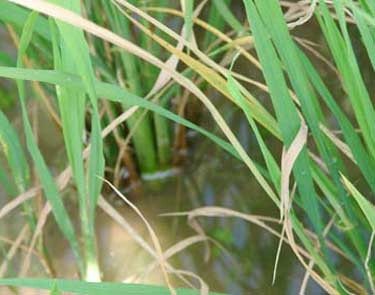Copper (Cu) deficiency
 Photo from Rice Knowledge Management PortalWhat it does
Photo from Rice Knowledge Management PortalWhat it does
Copper (Cu) deficiency affects the metabolic processes of rice plants, specifically photosynthesis and respiration. It can lead to reduced pollen viability and increase in spikelet sterility, thus developing many unfilled grains.
Why and where it occurs
Cu deficiency is relatively rare especially in irrigated rice systems. It is caused by the following:
- a small amount of Cu available in soil
- strong absorption of Cu on humic and fulvic acids (peat soils)
- a small amount of Cu present in parent materials (sandy soils derived from quartz)
- high NPK rates, causing rapid plant growth rate and exhaustion of Cu in soil solution
- overliming of acid soils, causing increased amount of Cu complexed by organic matter or adsorbed and occluded by hydroxides and oxides
- excessive Zn in the soil, inhibiting Cu uptake
Cu deficiency occurs on the following types of soils:
- high organic matter status soils (Histosols, humic volcanic ash soils)
- lateritic, highly weathered soils (Ultisols, Oxisols)
- soils derived from marine sediments (limestone)
- sandy textured soils
- calcareous soils
How to identify
Check the leaves for the following symptoms:
- chlorotic streaks on either side of the midrib
- dark brown necrotic lesions on leaf tips
- bluish green and chlorotic streaks near the leaf tip
- rolling of new leaves
New leaves do not unroll and the upper portion of leaves have a needlelike appearance, while the lower portion of the leaf appears normal
Plants also have reduced tillering.
When affected, pollen viability is reduced; this means, spikelets become sterile and develop unfilled grains.
To confirm Cu deficiency, bring soil and plant sample to a laboratory for testing.
Why is it important
Although rare in irrigated rice systems, the damage caused by Cu deficiency is important throughout the growth stage of the crop.
How to manage
There is currently no practical field management option for copper deficiency.
Where possible,
- dip seedling roots in 1% CuSO4 suspensions for 1 h before transplanting
- avoid overliming of acid soils because it may reduce Cu uptake
- on Cu-deficient soils, apply CuO or CuSO4 (5−10 kg Cu ha-1 at 5-year intervals) for long-term maintenance of available soil Cu (broadcast and incorporate in soil)







